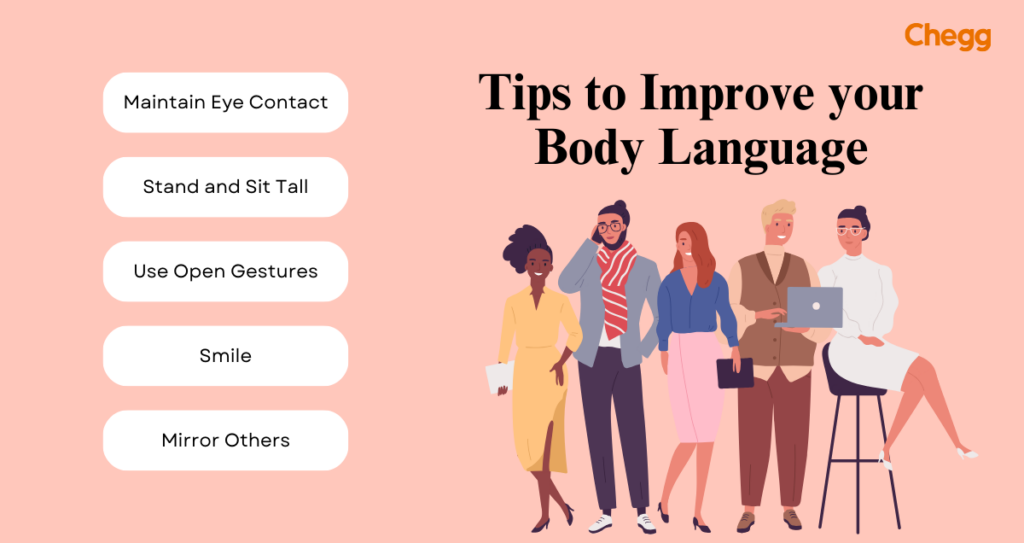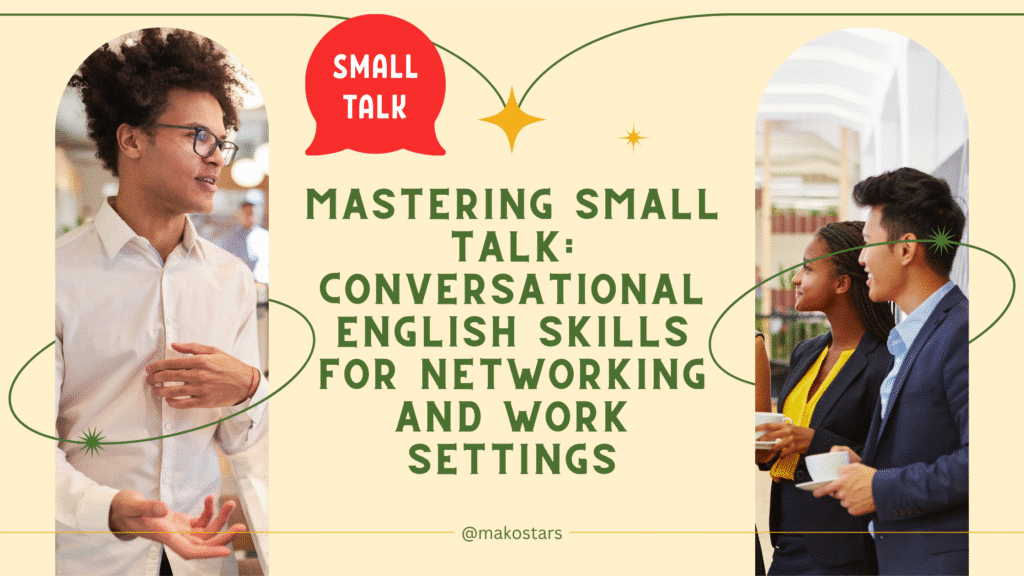Did you know that in a sales call, you have just seven seconds to establish rapport before the opportunity slips away? Small talk serves as a critical communication tool in American business culture.
At work, mastering the art of casual conversation can significantly improve your networking success.
You need to speak clearly while also listening attentively. Additionally, knowing which topics to avoid in office small talk—like politics, religion, and personal finances—is just as important as knowing which subjects to discuss.
Start with a Smile and Open Body Language

Image Source: Chegg India
The power of a genuine smile cannot be overstated when initiating small talk. Research shows that approximately 55% of communication is nonverbal, making your body language a crucial element in how your message is received.
A warm smile coupled with open body posture creates the perfect foundation for meaningful conversation in any professional setting.
Start with a Smile key benefits
Smiling triggers a powerful chemical reaction in your brain, releasing dopamine, endorphins, and serotonin. Neurotransmitters that increase happiness and reduce stress. Moreover, this simple facial expression offers numerous advantages in communication:
- Builds instant trust – People perceive smiling individuals as more trustworthy, competent, and approachable compared to those with neutral or frowning expressions
- Creates mirroring effect – When you smile at someone, they often unconsciously smile back due to what psychologists call “social mirroring,” establishing an immediate connection
- Reduces tension – A genuine smile can diffuse awkward moments and lower defenses in high-pressure situations
- Improves your mood – Even forcing a smile can boost your own emotional state through the facial feedback mechanism
Start with a Smile in business small talk
In business networking scenarios, your facial expression sets the tone before you even speak. A smile communicates warmth, friendliness, and approachability.
For negotiations and business discussions, a smile demonstrates confidence, openness, and energy. Nevertheless, balance is key.

Constant grinning without appropriate context might be perceived as insincere or misleading. The science behind an authentic business smile reveals it comes on gradually, slightly crinkles the face around the eyes, and leaves as slowly as it came.
When attending networking events, remember these body language principles:
- Maintain an open stance with uncrossed arms to signal approachability
- Lean slightly forward to demonstrate interest in the conversation
- Keep appropriate eye contact to convey attentiveness and confidence
- Complement your smile with occasional nodding to encourage speakers
Sales professionals primarily understand this concept.
A genuine smile during client interactions can be the difference between closing a deal and losing an opportunity. Studies consistently show that people prefer to do business with individuals they perceive as pleasant and approachable.
Start with a Smile in office small talk
The workplace environment presents daily opportunities to practice your small talk skills. Beginning with a smile when you’re first introduced to colleagues and maintaining pleasant facial expressions throughout office conversations creates a positive impression.
Small details in your body language significantly impact how approachable you seem to coworkers. For instance, looking down and hunching your shoulders signals you don’t want to speak with anyone. Similarly, frequently checking your watch or clock (yes, smartwatches count too!) suggests disinterest in what colleagues are saying.
Instead, try these techniques for effective office small talk:
- Stand or sit tall with good posture, conveying confidence
- Make direct eye contact while speaking, establishing trust
- Keep your body language expansive yet non-threatening
- Pay attention to your hand movements, using them purposefully for emphasis
Body language experts note that “high-power poses” not only telegraph confidence to others but also trigger hormonal changes that help you feel more powerful and perform more effectively. Before important meetings or presentations, consider taking a moment to adjust your posture and facial expression accordingly.
Ask Open-Ended Questions to Spark Dialog
Image Source: Mentimeter
Once you’ve made that positive first impression with a smile, the next critical skill in mastering small talk is asking thoughtful open-ended questions.
Unlike closed-ended questions that prompt simple “yes” or “no” responses, open-ended questions encourage detailed answers and genuine dialog. These questions typically begin with “what,” “how,” “why,” or phrases that invite elaboration.
The difference is substantial: asking “Did you enjoy the conference?” might get you a brief “Yes” or “No,” effectively ending the conversation.
However, asking “What did you find most valuable about today’s conference?” invites the other person to share their thoughts and experiences, creating a pathway to meaningful discussion.
Ask Open-Ended Questions examples
Effective open-ended questions should be personalized, unique, and appropriate for the situation. Generic questions like “What’s the weather like?” rarely lead to memorable connections, whereas specific, thoughtful questions demonstrate genuine interest in the other person.
For business networking, try these conversation starters:
- “What brought you to this event today?” – This reveals their immediate interests and goals
- “What aspects of your work do you find most rewarding?” – Uncovers their values and passions
- “How did you get started in your field?” – Invites them to share their professional journey
- “What’s something most people don’t realize about your industry?” – Encourages them to share unique insights
For social settings with colleagues:
- “What are you looking forward to this weekend/upcoming holiday?”
- “What’s something exciting you’ve been working on recently?”
- “How did you first become interested in [hobby or interest they’ve mentioned]?”
- “What’s the most interesting thing you’ve learned lately?”
Follow-up questions are equally important for deepening the conversation. When someone shares something, respond with questions like “Could you tell me more about that?” or “How did that impact you?” These follow-ups demonstrate active listening and encourage further sharing.
Ask Open-Ended Questions for small talk at work
Office environments provide daily opportunities to practice your open-ended questioning skills. These questions foster team cohesion, problem-solving, and professional development.
For team meetings:
- “What steps could we take to make our meetings more effective?”
- “How do you think our current project is progressing?”
- “What challenges are you facing with your current workload?”
For one-on-one conversations with colleagues:
- “What projects are you most excited about right now?”
- “How would you describe our working culture to someone new?”
- “What would make your work life better or more productive?”
A Cornell University study found that conversations where participants asked follow-up questions were rated as more enjoyable and led to greater feelings of connection. Therefore, don’t simply move from one question to another—build upon what you hear.
For brainstorming sessions, questions like “What alternative solutions could address this challenge?” or “How might we streamline this process?” encourage innovative thinking and collaboration. These open-ended approaches yield more thoughtful responses than simply asking if someone likes a particular idea.
Avoid rushing through your questions. Allow the conversation to flow naturally, giving your colleague ample opportunity to share their thoughts. This patience demonstrates respect and genuine interest in their perspective.
Ask Open-Ended Questions to build rapport
The primary purpose of open-ended questions in professional settings is building rapport—establishing a foundation of mutual understanding and trust. Rapport-building questions connect people on a personal level by evoking unique, memorable responses.
To build effective rapport, ensure your questions meet three key criteria:
Personalized: Show you’re genuinely interested in this specific person Unique: Make your question slightly unexpected to elicit honest answers Appropriate: While being surprising, avoid anything that could be perceived as invasive
Location-based questions work well for initial rapport building:
- “Since you’re based in [city], what would you recommend to someone visiting for the first time?”
- “I’ve heard [local attraction] is amazing. Have you had a chance to experience it?”
- “What’s something most people don’t realize about living in [their location]?”
Career-focused questions deepen professional connections:
- “What’s been your most interesting career pivot or transition?”
- “What aspects of your role contribute most to your job satisfaction?”
- “If you could design your ideal workday, what would it look like?”
Beyond just asking questions, genuine curiosity is essential. As you listen to responses, maintain eye contact, nod occasionally, and ask relevant follow-up questions based on what you hear. This active listening approach transforms transactional interactions into meaningful connections.
When forming questions, be mindful of using emotive verbs like “think,” “feel,” or “believe” to encourage reflection. Furthermore, frame questions neutrally to avoid sounding accusatory, which can hinder honest responses.
The impact of well-crafted open-ended questions extends beyond the immediate conversation. By showing interest in others and encouraging them to share their thoughts, you create lasting impressions and build relationships that can lead to future collaborations, mentorships, and professional opportunities.
Remember that mastering the art of asking engaging questions takes practice. Start with a few prepared questions before networking events or meetings, then adapt based on the flow of conversation.
With time, this skill becomes second nature, transforming even the most routine small talk into valuable professional interactions.
Use Active Listening to Show Engagement
Image Source: LinkedIn
Effective small talk involves a two-way exchange where listening is as crucial as speaking. Active listening—the practice of fully concentrating, understanding, and responding to a speaker—forms the backbone of meaningful professional conversations. Unlike passive hearing, active listening requires engagement and intentionality, transforming superficial exchanges into valuable connections.
Active Listening techniques
Active listening encompasses specific techniques that demonstrate your full engagement in a conversation:
- Pay attention – Give your complete focus to the speaker, maintaining eye contact and an open posture while avoiding distractions like phone notifications or surrounding activities
- Withhold judgment – Suspend personal opinions and criticisms until you’ve fully understood the speaker’s perspective, allowing for more open and honest communication
- Reflect and validate – Mirror the speaker’s emotions and paraphrase key points to confirm your understanding and make them feel heard
- Use minimal encouragers – Employ short verbal or non-verbal cues like nodding, saying “yes,” or “hmm” to encourage the speaker to continue elaborating
- Clarify through questions – Ask specific questions about ambiguous points rather than making assumptions about what the speaker means
- Summarize – Restate key themes at appropriate intervals to solidify understanding and demonstrate your attentiveness
The effectiveness of these techniques has been demonstrated in research settings. For instance, when Google measured active listening practices in the workplace, teams reported higher rates of innovative ideas, which was attributed to creating an environment where all members felt valued and encouraged to contribute.
Active Listening in business small talk
In networking environments, listening often takes precedence over speaking. As one networking expert notes, “Effective networking isn’t just about exchanging business cards or delivering an elevator pitch—it’s about building relationships grounded in mutual understanding and respect”.
When engaged in business small talk, these practices help establish meaningful connections:
- Be present – Stay fully engaged in the moment rather than mentally preparing your next comment or scanning the room for other networking opportunities
- Follow body language – Notice non-verbal cues that may reveal emotions behind words, adjusting your responses accordingly
- Avoid multitasking – Give your full attention to each conversation partner, signaling that you value their time and perspective
- Practice patience – Allow the speaker adequate time to express their thoughts without interruption, which demonstrates respect and encourages deeper sharing
These practices yield tangible benefits in professional settings. Teams that practice active listening report increased collaboration and more harmonious working relationships. Likewise, active listening helps create environments where ideas flow freely and misunderstandings are minimized.
For small talk at work, active listening provides a foundation for trust. When colleagues feel heard, they’re more likely to share ideas, collaborate effectively, and develop stronger professional bonds. One study showed that employees felt more comfortable sharing ideas and feedback when they knew they would be heard and respected.
Active Listening to deepen conversations
Beyond basic techniques, several advanced active listening practices can transform routine small talk into meaningful exchanges:
Silence as a tool – Becoming comfortable with pauses gives the speaker time to reflect and often leads to deeper sharing. As one expert notes, “The silence that may occur when actively listening allows you to hear the other person’s thoughts instead of your own”.
Emotional recognition – Acknowledging the emotions behind someone’s words—through phrases like “That sounds frustrating” or “You seem excited about this project”—demonstrates empathy and encourages further sharing.
Balancing questions with reflection – While asking questions (covered in the previous section) is important, balancing inquiries with reflective statements shows you’re processing what’s being shared rather than just preparing the next question.
Active listening fundamentally shifts the focus from yourself to the other person. This shift in perspective creates space for deeper connections that transcend typical workplace interactions. Research indicates that leaders who master active listening build stronger teams and foster environments where innovation thrives.

Beyond workplace settings, active listening proves valuable in all networking contexts. At networking events, effective listeners distinguish themselves by understanding not only what someone does professionally but who they are as a person.
This deeper understanding creates opportunities for authentic conversations that may lead to collaboration or business opportunities.
As you practice small talk in various professional settings, remember that listening isn’t passive—it’s an active, intentional process requiring as much skill as articulate speaking.
Through consistent application of these techniques, you’ll build stronger professional relationships, gain deeper insights, and position yourself as someone worth knowing and doing business with.
Conclusion: The First Step to Mastering Small Talk
In fast-paced professional environments – whether it’s a sales call, conference, or just chatting with coworkers. Small talk isn’t small at all. It’s the opening move in any meaningful interaction, often determining how well you’re received, remembered, and respected.
We’ve covered how a genuine smile, thoughtful open-ended questions, and active listening can instantly elevate your conversational presence. These tools aren’t just tricks—they’re foundational skills that signal professionalism, empathy, and approachability. Practicing them regularly can transform awkward silences into engaging moments that build trust and open doors.
But knowing how to speak is only part of the puzzle. Just as important is knowing what to say.
👉 In Part 2 of this series, we’ll explore small talk topics that work across different work settings—from first introductions to team catch-ups. You’ll learn which subjects to lean into (and which to avoid), how to read the room, and how to keep conversations flowing without forcing them.
Stay tuned. You’re already halfway to mastering English small talk. Now let’s make sure you always have something smart, warm, or interesting to say.



